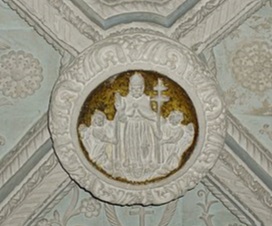
San Lucifero nella cattedrale di Cagliari
(Saint Lucifero in the Cagliari Cathedral).
Cagliari Cathedral is a Roman Catholic
cathedral located in Cagliari, Sardinia, Italy.
San Lucifero da Cagliari
aka Saint Lucifer of Cagliari
 San Lucifero nella cattedrale di Cagliari (Saint Lucifero in the Cagliari Cathedral). Cagliari Cathedral is a Roman Catholic cathedral located in Cagliari, Sardinia, Italy. |
Saint Lucifer of Cagliari (Latin: Sancte Lucifer Calaritanus; Italian: San Lucifero da Cagliari) was a bishop of Cagliari in Sardinia. Saint Lucifer of Cagliari died May 20, 370 or 371. Thus, his feast day is May 20th. He is widely venerated as a saint in Sardinia. The name “Lucifero” is common name for Sardinian boys born on his feast day.
Saint Lucifer was known for his passionate opposition to the heresy of Arianism. (Arianism--the concept that Jesus Christ, as the Son of God, was created by God—instead of eternally co-existing as one of the three persons of the Trinity. Thus, Arianism is a “nontrinitarian” doctrine of Christ.) Arianism remained popular in much of the Western Roman empire, even after it was denounced as a heresy by the Council of Nicaea in 325. He seems to have pissed off both the Emperor Constantius II and Saint Jerome of Stridon. By the way, this is the Saint Jerome who is best known for being commissioned by Pope Damasus to create an acceptable Latin version of the bible in 382.
Saint Lucifer was banished off in turn to Germanicia, Palestine, and finally Thebais in Egypt. After the death of Constantius II, Saint Lucifer--and some other exiled bishops--were permitted to return home in either 361 or 362.
Saint Lucifer of Cagliari died May 20, 370 or 371. His feast day is May 20th He is widely venerated as a Saint in Sardinia.
His followers were called “Luciferians,” and were attacked by Saint Jerome in his polemical dialogue Altercatio Luciferiani et Orthodoxi ("Quarrel between Luciferians and Orthodox") of 378. By the way, Saint Jerome is responsible for the name “Lucifer” appearing in the bible verse Isaiah 14:12:
Quomodo cecidisti de caelo Lucifer, qui mane oriebaris? Corruisti in terram, qui vulnerabas gentes? Qui dicebas in corde tuo: In cælum conscendam, super astra Dei exaltabo solium meum, sedebo in monte testamenti, in lateribus Aquilonis, Ascendam super altitudinem nubium, similis ero Altissimo. Verumtamen ad infernum detraheris in profundum laci: --Isaias 14:12-13The King James Version retained the translation of "Lucifer" for what was a poetic reference to the morning star in the original Hebrew text. More modern versions of the bible have attempted more accurate translations of scripture. They are too numerous to list them all, but here are translations from the English Standard Version and the New International Version.How art thou fallen from heaven, O Lucifer, son of the morning! how art thou cut down to the ground, which didst weaken the nations! For thou hast said in thine heart, I will ascend into heaven, I will exalt my throne above the stars of God: I will sit also upon the mount of the congregation, in the sides of the north: --Isaiah 14:12-13 King James Version
“How you are fallen from heaven,The New International Version translated the phrase in Isaiah 14:12 as "morning star, son of the dawn!" (I added bold-facing for emphasis of the various translations of the word in the original Hebrew passage.)
O Day Star, son of Dawn!
How you are cut down to the ground,
you who laid the nations low! ..."
--Isaiah 14:12 English Standard Version
Saint Jerome personally disliked Bishop Lucifer of Cagliari and disapproved of this bishop's stance against the Arian heresy. He apparently inserted the name, Lucifer, into a passage which he purposely identified with a fallen angel. In fact, the name Lucifer was once used as a title of Jesus Christ, the Light of the World.
Sources
Lucifer of Cagliari, CatholicSaints.Info - notes about your extended family in heaven, accessed 6/03/2020.
Lucifero di Cagliari,
Da Wikipedia, l'enciclopedia libera. accessed May 20, 2020